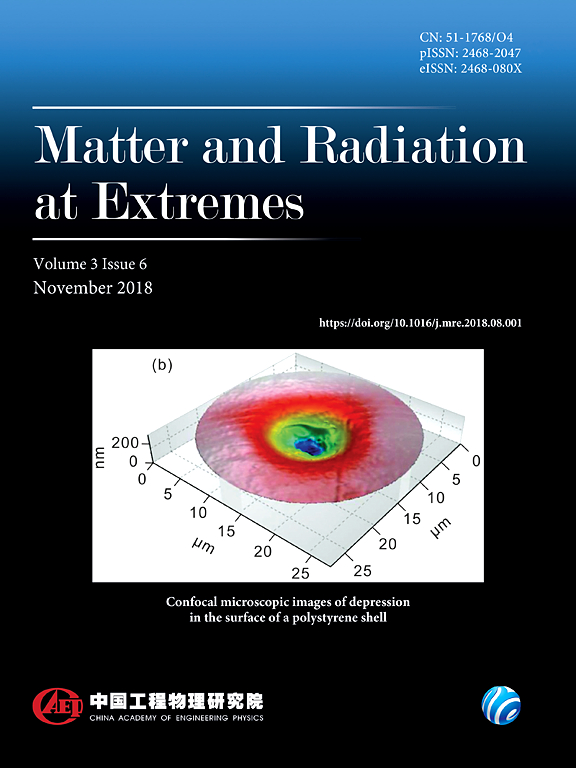论金属玻璃准各向同性压缩过程中的塑性热力学
IF 4.7
1区 物理与天体物理
Q1 PHYSICS, MULTIDISCIPLINARY
引用次数: 0
摘要
准各向同性压缩(QIC)中的熵产生对于了解极端条件下的材料特性至关重要。然而,这种情况下熵的起源和精确量化仍是长期存在的挑战。本研究建立了一个框架,用于量化 QIC 中熵的产生和分配及其与微观结构变化的关系。以 Cu50Zr50 为模型材料,通过分子动力学模拟其压缩过程。在原子模拟物理性质和自由能的基础上,恢复了热力学路径,并通过提出的框架成功地量化了熵的产生及其与微观结构变化的关系。与直觉不同的是,当γ̇ 在 7.5 × 108 至 2 × 109/s (QIC 实验中可达到的数值)范围内时,金属玻璃 QIC 过程中的熵产生对应变速率γ̇ 相对不敏感,其量级为 10-2kB/atom per GPa。然而,当γ-Joint 达到极高值(>2×109/s)时,熵产生率会随着γ-Joint 的增加而显著增加。泰勒-昆尼系数随应变而变化,但在模拟体系中并不随应变速率而变化。结果表明,与振动部分相比,熵的产生主要受构型部分的影响。在对速率不敏感的机制中,构型熵的增加与微结构变化的香农熵定量呈线性关系,而与泰勒-昆尼系数呈拉伸指数关系。熵的量化有望为微结构演变与塑性耗散之间的基本关系提供热力学见解。本文章由计算机程序翻译,如有差异,请以英文原文为准。
On the thermodynamics of plasticity during quasi-isentropic compression of metallic glass
Entropy production in quasi-isentropic compression (QIC) is critically important for understanding the properties of materials under extreme conditions. However, the origin and accurate quantification of entropy in this situation remain long-standing challenges. In this work, a framework is established for the quantification of entropy production and partition, and their relation to microstructural change in QIC. Cu50Zr50 is taken as a model material, and its compression is simulated by molecular dynamics. On the basis of atomistic simulation-informed physical properties and free energy, the thermodynamic path is recovered, and the entropy production and its relation to microstructural change are successfully quantified by the proposed framework. Contrary to intuition, entropy production during QIC of metallic glasses is relatively insensitive to the strain rate γ̇ when γ̇ ranges from 7.5 × 108 to 2 × 109/s, which are values reachable in QIC experiments, with a magnitude of the order of 10−2kB/atom per GPa. However, when γ̇ is extremely high (>2×109/s), a notable increase in entropy production rate with γ̇ is observed. The Taylor–Quinney factor is found to vary with strain but not with strain rate in the simulated regime. It is demonstrated that entropy production is dominated by the configurational part, compared with the vibrational part. In the rate-insensitive regime, the increase in configurational entropy exhibits a linear relation to the Shannon-entropic quantification of microstructural change, and a stretched exponential relation to the Taylor–Quinney factor. The quantification of entropy is expected to provide thermodynamic insights into the fundamental relation between microstructure evolution and plastic dissipation.
求助全文
通过发布文献求助,成功后即可免费获取论文全文。
去求助
来源期刊

Matter and Radiation at Extremes
Physics and Astronomy-Atomic and Molecular Physics, and Optics
CiteScore
8.60
自引率
9.80%
发文量
160
审稿时长
15 weeks
期刊介绍:
Matter and Radiation at Extremes (MRE), is committed to the publication of original and impactful research and review papers that address extreme states of matter and radiation, and the associated science and technology that are employed to produce and diagnose these conditions in the laboratory. Drivers, targets and diagnostics are included along with related numerical simulation and computational methods. It aims to provide a peer-reviewed platform for the international physics community and promote worldwide dissemination of the latest and impactful research in related fields.
 求助内容:
求助内容: 应助结果提醒方式:
应助结果提醒方式:


